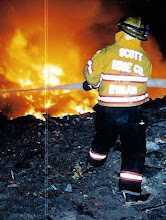A
hitch in the process of getting out the door as fast as possible remained, some
thought. Getting from the bunkroom on an upper floor to the apparatus was
slowed by the common use of circular stairs which were in place to keep the
horses from trying to leave the first floor.
At
Engine 21 in Chicago, Captain David Kenyon saw one of his firefighters slide a
wooden binding pole, typically used on a hay wagon during transport, which had
been temporarily stored vertically in the loading area of the hayloft, when a
call was received while he was working in the third floor loft. Recognizing a great idea when he saw it,
Captain Kenyon arranged for a hole from the second floor bunk room to the
apparatus floor, and the crew took a Georgia pine beam and rounded and sanded
it to 3 inch diameter. Varnished and
coated with paraffin wax, it was ready for service.
Firefighters
at the other stations laughed until they saw Engine 21beating them to fires,
and eventually the Chief decided to have poles installed in all Chicago
stations. In 1880, the Boston Fire
Department installed the first brass pole, which became the standard going
forward.
The
poles became part of fire department heritage, memorialized on television and
in movies—think Batman and Ghostbusters.
Now gone from most stations, another of the classic era trappings fading
from use, the pole remains a memory of an important period which will hopefully
not be forgotten.





No comments:
Post a Comment